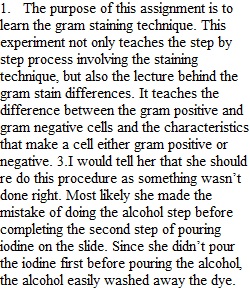


Q Required Resources • Complete the Week Prelab Activity (Connect) Instructions Welcome to the (online) lab page. You should have already completed the Lab Safety virtual lab simulation on Labster. Here is where you will upload your completed lab document. Grading This activity will be graded using the rubric in the lab document. Course Outcomes (CO): 4 Due Date: By 11:59 p.m. MT on Sunday Lab 3: The Gram Stain: Identify and differentiate bacteria Learning Outcomes • Describe the structure of the Gram-positive and Gram-negative bacteria. • Identify theoretical and technical aspects of the Gram staining procedure. • Identify the most commonly made mistakes in Gram staining. • Analyze the results of a Gram staining experiment using a light microscope. About the Gram Stain: Identify and differentiate bacteria Virtual Simulation Lab Did you know that there are approximately 5 million-trillion-trillion bacteria in the world? Most of them are harmless, but some can induce disease in an affected host. In this simulation, you will help doctors identify bacteria in a cerebrospinal fluid sample from a patient suspected of suffering from bacterial meningitis. Explore the bacterial cell wall Compare and contrast the cell wall of Gram-positive and Gram-negative bacteria by building your very own bacterial 3D models on the hologram table. Enter the exploration pod to observe in an immersive animation how the four reagents of the Gram stain interact with structural components of the cell wall to color the bacteria. Perform the gram stain When the patient’s fluid sample arrives at the laboratory, equip yourself with protective gear to prepare a bacterial smear and heat fix it to a glass slide. You are now ready to perform the Gram stain in a safe virtual environment. Made a mistake? No worries, hit the big red button on the workbench to repeat the staining procedure until it becomes second nature. Interpret your findings using a microscope In the end, you will use a light microscope to interpret the results of your Gram stain. View the microscopic image on the computer screen, and apply immersion oil to increase magnification 1000x! Will you be able to identify the presence of any bacteria in the patient´s cerebrospinal fluid? Questions: 1. Purpose: Please describe in complete sentences and in your own words, the purpose of this experiment. 2. Complete the following table by predicting colors of bacteria with- and without cell wall as they are processed through the steps of Gram staining.3. A fellow student showed you a gram stained slide where cells containing thick cell walls were stained pink. What would you tell her about the staining procedure? Why? 4. A fellow student showed you a gram stained slide where cells containing LPS were stained purple. What would you tell her about the staining procedure? Why?
View Related Questions